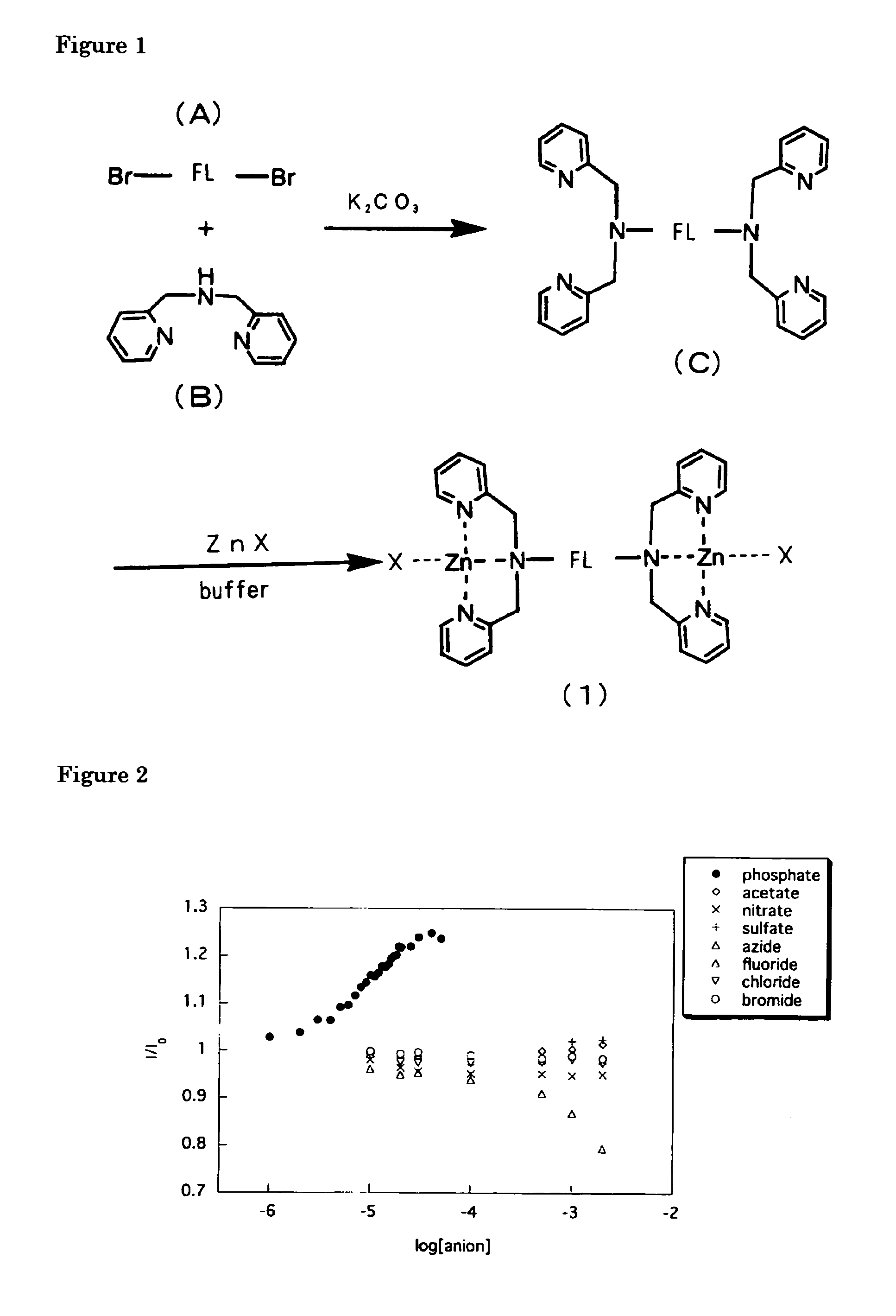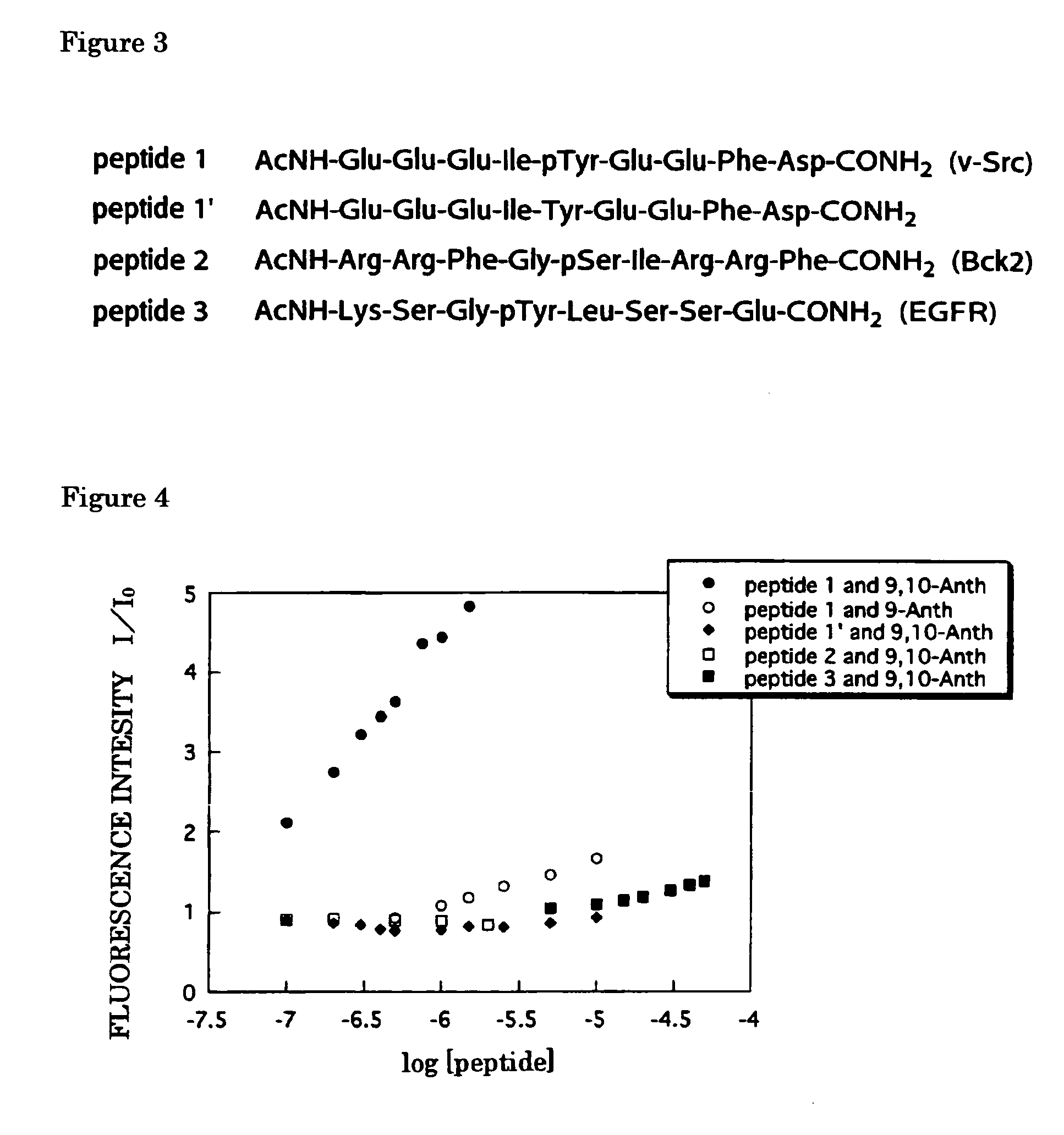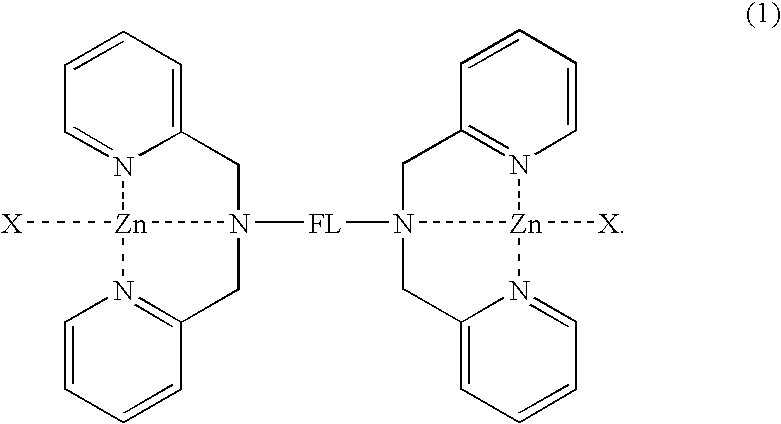Fluorescent sensor for phosphate ion and phosphorylated peptide
a fluorescent sensor and phosphate ion technology, applied in the field of anion detection, can solve the problems of difficult chelation, almost nothing for use in in vivo media, and inability to detect anion particles
- Summary
- Abstract
- Description
- Claims
- Application Information
AI Technical Summary
Benefits of technology
Problems solved by technology
Method used
Image
Examples
example 1
Synthesis of Fluorescent Compound
[0025]As a fluorescent compound of the present invention, Zn(Dpa)-9,10-Anth complex, as expressed by the aforementioned formula (3), was synthesized as follows.
[0026]Firstly, a compound in which two Dpa's are combined with one another via a demethylanthlyl group (a compound C in FIG. 1) was synthesized in the following manner: Into a 50 ml two-necked flask were charged potassium iodide 0.12 g, potassium carbonate 1.05 g, 9,10-bis(chloromethyl) anthracene (A) 0.50 g. Following deaeration with nitrogen, the mixture was dissolved in 10 ml dimethylformamide. On adding 0.6 ml dipicolylamine (B), the resultant was kept at 35° C. for six hours and then at 45° C. overnight while being stirred. The insolubles were subjected to filtration and the filtrate was distilled off in vacuo. The resultant residue was dissolved in chloroform, followed by washing with 0.01N sodium hydroxide aqueous solution. The organic phase was concentrated and purified by chromatograp...
example 2
Experiment on Anion-Selectivity
[0029]Using Zn(Dpa)-9,10-Anth complex prepared in Example 1 as a fluorescent compound of the present invention, measurements were conducted on fluorescence change with changing concentration of anions. The types of anion measured were phosphate ion, acetate ion, nitrate ion, sulfate ion, azide ion, fluoride ion, chloride ion and bromide ion, all of which were dissolved as sodium salt in an aqueous solution. The experimental conditions were as follows.[0030]Concentration of Zn(Dpa)-9,10-Anth complex: 10 μM[0031]Concentrations of the anions: 0, 10, 20, 30, 100, 500, 1000, 2000 μM (0˜200 eq.)[0032]Aqueous solution: pH 7.2, 10 mM, HEPES buffer[0033]Measurement temperature: 20° C.[0034]Measurement cell: 1 cm cell[0035]Excitation wavelength λex: 380 nm (ex / em=2.5 / 2.5 nm)
[0036]The results of the measurements are given in FIG. 1. As shown by the figure, there were observed no substantial changes in the fluorescence intensity with anions other than phosphate an...
example 3
Experiment on Sequence-Selectivity to Peptides
[0037]Using Zn(Dpa)-9,10-Anth complex of the aforementioned formula (3), experiments were conducted on fluorescence change when the complex reacts with peptides having varying sequences, so as to evaluate the selectivity thereto. For comparison, a similar experiment was carried out using a mononuclear complex having only a single Zn(Dpa) as expressed by the formula (4) below (The compound of the formula (4) is hereinafter abbreviated as Zn(Dpa)-9,10-Anth complex).
[0038]
Synthesis of Peptides
[0039]The experiment was carried out using peptides having amino acid sequences as shown in FIG. 3. The N-terminus of each peptide is protected through acethylation while the C-terminus thereof is of an amide structure. The amino acid sequences of peptides 1, 1′, 2 and 3 are listed, in the later-mentioned Sequence Listing, as the Sequence Nos. 1, 2, 3 and 4, respectively. Peptides 1, 2 and 3 each constructs a consensus sequence for phosphorylation by a...
PUM
| Property | Measurement | Unit |
|---|---|---|
| anion-selective fluorescent | aaaaa | aaaaa |
| fluorescent | aaaaa | aaaaa |
| fluorescent intensity | aaaaa | aaaaa |
Abstract
Description
Claims
Application Information
 Login to View More
Login to View More - R&D
- Intellectual Property
- Life Sciences
- Materials
- Tech Scout
- Unparalleled Data Quality
- Higher Quality Content
- 60% Fewer Hallucinations
Browse by: Latest US Patents, China's latest patents, Technical Efficacy Thesaurus, Application Domain, Technology Topic, Popular Technical Reports.
© 2025 PatSnap. All rights reserved.Legal|Privacy policy|Modern Slavery Act Transparency Statement|Sitemap|About US| Contact US: help@patsnap.com



